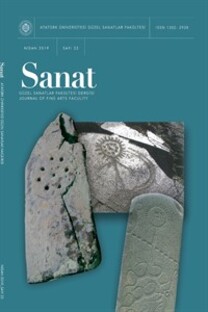El Dokumacılığının ve El Dokuma Tezgahının Tarihçesi, El Dokuma Tezgahı Çeşitleri
The History of Hand-Weaving, Hand-Weave Loom, Kinds of Hand-Weave Loom
Looms and loom materials, which are used in wovens, are changed for a long time In 1962, digging was made in that BC 6000's, Anatolia was disputed in this subject. These take us to pre-historic ages. So, it must be essential to say woven beginning is the same with thread finding. It is understood that the most basic woven were made by marshy-places rush, flowering rush, bulrush and the longest horsehair. After the wool usage, weaving became developed. In this period, people make thread with spinning. Only after this, the weaving sector developed regularly. Primary human beings put a horizontal thick stick on two fork-shape thick sticks. They hanged warp-rope to it and tied big-heavy stones to each rope's ends. With the help of each other, they cross the weft-rope and they found basic weaving we say plain weave. Later, the idea which the warp- ropes weren't lifted one by one, they were lifted together in an order was developed; horizontal looms are on the 3rd order. These kinds of looms were formed by branch using instead of stones. Nowadays, hand-weaving looms are used at homes in developing countries. And also, some valuable and special waving products are weaved in handlooms.
___
1. ANONİM., "Dokumacılık" Türkiye Gazetesi, 6. cilt, İstanbul, 1993, s.38-40.2. BÜKEN, R., Ulaşılabilen Yayınlarda ve Bazı Müzelerimizde Bulunan Anadolu Kökenli Arkeolojik Tekstiller (M.Ö 8000 sonu). Teknik Çözümlemeleri ve Konservasyonu, Yayımlanmamış Sanatta Yeterlilik Tezi. Dokuz Eylül Üniversitesi, Sosyal Bilimler Enstitüsü, Geleneksel Türk El Sanatları Anasanat Dalı, İzmir, 1999, s. 1,22,27,30, 299s.
3. DENİZ, B., Türk Dünyasında Hah, Düz Dokuma Yaygıları, Atatürk Kültür Merkezi Başkanlığı Yayınları, İzmir, 2000, s.20.
4. GÖNÜL, M., "Dokumacılığın Tarihçesi ve En Eski Dokuma Aletleri", Antropoloji Dergisi, 1. cilt, (2. Sayı), İstanbul, 1964.
5. HARRIS, J., 5000 Years of Textiles, British Museum Press London, 1995.
6. İMER, Z., Dokuma Tekniği. Tekstil Dipl. İng. Ankara, 1987, s. 1-3. ÖZEL, A., Halıcının El Kitabı, Sümerhalı. Ankara, 1986, s.6-44.
7. UĞURLU, A., "Antik Çağ Anadolu Dokuma Sanatı", İlgi dergisi, yıl: 19, (sayı: 43), İstanbul, 1985, s.l 1-17.
8. UĞURLU, A., "Klasik Çağ Anadolu Dokumacılığı", İlgi Dergisi, yıl:20, (sayı: 46), İstanbul, 1986, s.2-7.
9. YAĞAN, Ş. Y., Türk El Dokumaları. İş Bankası, İstanbul, 1978.
10.YAZICI, N., Tarihte Türkler ve Türk Devletleri. Damla Matbaası, Konya, 1997, s.65-77, 285.
11.http://destech.uludag.edu.tr/tarihiyleurun.htm, Erişim Tarihi:31.03.2004
12.http://www. lu .se/klass/textiles/textileinpractice. html, ErişimTarihi:31.03.2004
13.http://www.siskoosman.com/techniques_tr.htm, Erişim Tarihi: 03.04.2004
14.http://www.sihirlitur.com/gezi/denizli/foto.htmlf, Erişim Tarihi 03.04.2004
- ISSN: 1302-2938
- Yayın Aralığı: Yılda 2 Sayı
- Başlangıç: 1999
- Yayıncı: Cordus
Sayıdaki Diğer Makaleler
Geçmişten Günümüze Erzurum'da Bakırcılık ve Bakır Kaplar
Propp Metodu ve Bir Karagöz Metnine Uygulanması
LEVENT MERCİN, ALİ OSMAN ALAKUŞ
El Dokumacılığının ve El Dokuma Tezgahının Tarihçesi, El Dokuma Tezgahı Çeşitleri
Eğitimde Program Geliştirme Bağlamında "Müzik Eğitimimiz"
İzmir Atatürk Müzesi Deposunda Bulunan Cicim Örneklerinin Benzer Yöre Örnekleriyle Karşılaştırılması
